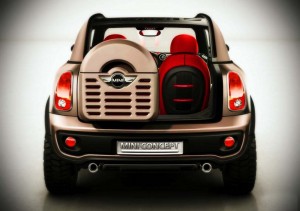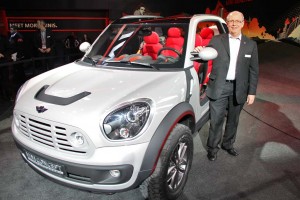There’s more than a faint resemblance between the new Mini Beachcomber concept vehicle and a classic dune buggy.
The show car is missing a roof and the removable doors are little more than frames. So, it takes a little imagination to recognize that Beachcomber is the starting point upon which a variety of future products could be built by the British brand, says Jim McDowell, head of Mini’s U.S. subsidiary.
“You can assume Beachcomber has a lot in common with the crossover we have coming,” suggests McDowell, during a conversation on the automaker’s stand at the 2010 North American International Auto Show. And, he adds, “even more things” could follow, sharing the new platform, “a lot of fun products you could make.”

The Mini Beachcomber concept features some distinctive design elements, such as the cental rail system, with modular storage, and the external trunk, shown here. Watch for them to migrate to Mini's upcoming crossover.
While the all-wheel-drive architecture of the Beachcomber-cum-crossover is still modest in size by American standards, McDowell notes it is nonetheless a step up from the pint-sized Mini that has proven such a success around the world.
“We’ve gone,” he laughs, “from astonishingly small to small.”
Just how much more the Mini line-up will grow remains to be seen. Two other new models, the Coupe and Roadster, were shown at last year’s Frankfurt Motor Show, and will soon join the expanding line-up, though McDowell stresses that the British-based brand has no intention of going mainstream, no interest in rivaling the sales of a Toyota or Volkswagen.
That’s not to say it hasn’t grown in volume in recent years. Last year, worldwide sales came in at 216,538, a roughly 7% drop in a wounded industry. In the U.S., volumes were off a steeper 16%, falling to 45,225, but that was still better than the industry overall, officials point out.
Part of Mini’s growth strategy is to explore not only alternative body designs but powertrain technology, as well. The company was planning to wrap up a field test of its MiniE battery cars, in June, but customers have become so attached to the emissions-free vehicles that the BMW subsidiary plans to extend the leases.
Electric power “is very consistent with the brand imagery,” contends McDowell, but he cautions that the automaker’s conventional engines are so efficient it makes it difficult to justify going to alternative power – at least on a financial basis. On the other hand, the company may eventually bring a next-generation version of its diesel line to the U.S. in the mid-term.
If Mini has one problem, it’s that it hasn’t scored well in some recent quality studies, notably including J.D. Power’s Initial Quality Survey, which focused on cars in their first months on the road. McDowell say the results are a bit misleading because Minis actually suffer from relatively few defects. But they get dinged in the studies, he contends, because of the very quirkiness that owners admire.
The center-mounted speedometer is an example, as it turns off buyers less familiar with the brand. The challenge, he concludes, is to find a way to let Mini be Mini, while improving ergonomics. “We’re always looking for a better way.”
So, look for some new ideas to show up on the new crossover vehicle, including a rail system, previewed on the Beachcomber, that extends from the front seats to the rear will have modular bins for things like cupholders and cellphones, as well as places to clip your GPS system or sunglass cases. A similar rail system, as well as an outside rear storage bin will likely also make the transition from Beachcomber concept to production crossover.

